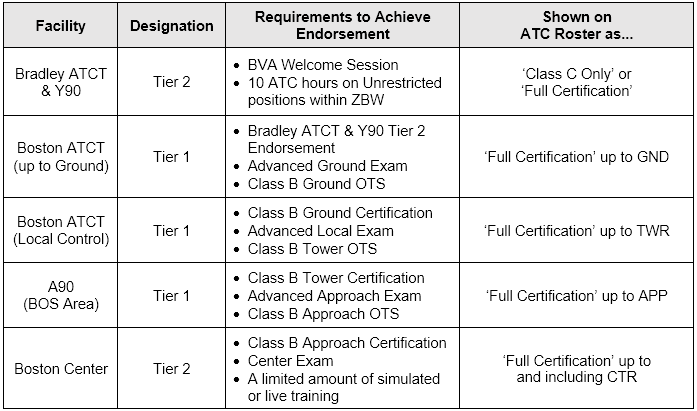Visiting and Transferring Controllers
This page contains all procedures specific to Visiting and Transferring Controllers at Boston Virtual ARTCC (BVA or the ZBW ARTCC).
- Visiting Controllers are VATSIM controllers who, while remaining active at their home facility, are authorized to control within ZBW airspace.
- Transferring Controllers are VATSIM controllers who change from their current home facility and become home controllers at ZBW.
- The word "prospective" before "Visiting Controller" or "Transferring Controller" refers to a VATSIM controller who wishes to visit at or transfer to ZBW, but has not yet been added to the BVA ATC roster.
The information on this page is current as of April 19, 2024.
Individuals who wish to become a controller at BVA but do not hold active ratings from another facility should consult the General SOP or our Become a Controller page for information on how to get started.
General
BVA operates in accordance with VATSIM's Global Controller Administration Policy (GCAP), VATSIM's Transfer and Visiting Controller Policy (TAVP), and VATUSA Division Policies to protect the quality of air traffic control on VATSIM.
Any controller requesting to visit at or transfer to BVA will be subject to a history check. Requests may be declined on the basis of disciplinary matters, prior performance, or any other reasons determined applicable by the Air Traffic Manager and/or Deputy Air Traffic Manager.
In accordance with VATUSA policy, visiting controllers must hold at least the S3 rating and must have consolidated this rating by performing at least 50 controller hours the ARTCC where the rating was granted prior to apply to visit a new ARTCC or before utilizing the new rating in the ARTCC the controller is already visiting. Existing visitors who gain a new rating must complete the consolidation period for their new rating before utilizing that new rating as a visitor.
Applying as a Visiting Controller
Prospective Visiting Controllers must:
- Complete the BVA Orientation on VATUSA (see instructions at the bottom of this page).
-
Once the BVA Orientation is complete, email BVA's Air Traffic Manager (ATM) at [email protected] with the following information:
- The controller’s name, VATSIM ID, and current rating.
- The controller’s home ARTCC and current certification.
- Relevant background about the controller’s real-world or virtual aviation experience that may contribute to the controller’s request to visit.
- The reason the controller wishes to visit at BVA.
The controller can expect to receive a reply from the ATM within 5 business days.
Applying as a Transferring Controller
Prospective Transferring Controllers must:
- Complete the BVA Orientation on VATUSA (see instructions at the bottom of this page).
-
Once the BVA Orientation is complete, apply to transfer through VATUSA:
- Login to the VATUSA website.
- Click "Transfer Request" under "My VATUSA" and complete the process.
Transferred controllers holding an instructor rating shall surrender the instructor rating and return to the last held grade, unless a specific arrangement to transfer an instructor into the BVA Instructor Staff is made with the Training Administrator, and approved by the ATM and the VATUSA Training Department.
Approval and Roster Addition
Upon approval, a Transferring or Visiting Controller will be added to our roster and become a member of BVA's integrated community of pilots and air traffic controllers. This membership remains valid until specifically cancelled by the controller, even if the controller becomes inactive or is removed from the ATC program.
Once added to the roster, the controller should:
- Read BVA's General SOP, which contains everything you need to know about controlling at our facility.
- Complete a BVA Welcome Session (see below).
- Spend some time getting to know our facilities and members by controlling a minimum of 10 hours (as per VATUSA DP001).
- Consider pursuing Tier 1 or Tier 2 Endorsements, if desired.
BVA Welcome Session
Before connecting to the network within the ZBW ARTCC, visiting and transferring controllers should schedule a BVA Welcome Session with a Mentor or Instructor. This can be scheduled using our Request Training page. Request the following certification:
- If you are an S1: Class C GND
- If you are an S2: Class C TWR
- If you are an S3: Class C APP
The session takes approximately 90 minutes and is often scheduled within a few days of the initial request. During the session, a Mentor or Instructor will walk through some of the key differences about operating in the ZBW ARTCC, including our WINGS program. Following the welcome session, the controller will automatically receive the Tier 2 endorsement for the Bradley ATCT & Y90, which will become effective after 10 hours of controlling within ZBW.
Completion of the BVA Welcome Session is indicated by the 'Class C Only' certification on the ATC Roster.
Designated Airspace
Once the Welcome Session is complete and you have had some time to get to know our facilities and members, you may wish to obtain Endorsements to work our Designated Airspace. The table below defines the Designated Airspace within Boston ARTCC, along with the requirements to achieve the necessary endorsements:

Where an exam is required, it may be requested using our Request Exam page. An exam is considered complete once a passing grade of 80% or higher is received, and the controller has completed Test Corrections.
An 'OTS', or Over-the-Shoulder, is a practical examination conducted by a Mentor or Instructor. Once the requisite exam is completed and Test Corrections are approved, the controller may request training for the applicable certification training.
BVA Orientation on VATUSA
Prior to joining BVA's roster, a Transferring or Visiting Controller will complete the BVA Orientation on VATUSA. All information required to successfully complete the exam is listed on this page. To do so, enrol in the BVA Orientation for Prospective Visiting and Transferring Controllers from the VATUSA Academy. If you are unable to enrol in the course, please email your name and VATSIM CID to [email protected], who will assign the course to you.
Controllers familiar with the following information should be able to complete the BVA Orientation:
-
The following sections/chapters of the General SOP: Section 2.3, 4.1, 4.5, 4.9, Chapters 5-6, Chapter 9.
- We recommend Transferring and Visiting Controllers read the entire document, and have it available for reference while controlling.
- Visiting and Transferring Controllers may also find our ATC Handbook helpful. This document is 'our interpretation of the 7110.65' and is the source material for all our home controller training.
-
BVA typically sees a high volume of VFR, helicopter, and general aviation traffic. If your (previous) home facility did not tend to see many VFR operations, you may wish to review the VFR sections in Chapters 3, 5, and 6 in our ATC Handbook.
- VFR departures from Class C Airports are typically given an altitude restriction as specified by Facility SOP, and assigned a heading within the departure corridor by the Local controller. The overlying radar facility will then issue higher and on course instructions.
- VFR arrivals at Class C Airports are sequenced by the overlying radar controller. Unless coordinated, Tower simply needs to issue a landing clearance, as the Class C VFR arrival will already have been issued pattern entry/sequencing.
-
BVA uses both Discord and TeamSpeak:
- Discord is used for textual communication, screensharing, and streaming. There is no ATC coordination conducted in Discord.
- TeamSpeak is used for ATC coordination and social interaction while off position.
- The 'Sterile Controlling Rooms' in TeamSpeak are restricted to active controllers conducting coordination.
- Prior to connecting to the network to control, controllers must follow the procedure outlined in General SOP Section 5.6.
- BVA is an integrated community of pilots and air traffic controllers. This means we have both controllers and pilots present in Discord, TeamSpeak, and on the forums.
- BVA has an integrated training program called Wings Over New England (WINGS). Pilots complete a series of structured training flights that are monitored by ATC. Controller responsibilities for WINGS flights are outlined in Chapter 6 of the General SOP.
- Pilots flying using the Cape Air callsign "CAIR" may request Cape Air Coded Routes. Details on these routes are published in facility-specific SOPs and the Cape Air Coded Routes document.
